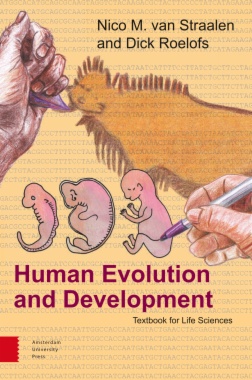Our understanding of human evolution is proceeding at an unprecedented rate over the last years due to spectacular fossil finds, reconstructions based on genome comparison, ancient DNA sequencing and new insights into developmental genetics. This book takes an integrative approach in which the development of the human embryo, the evolutionary history of our body, the structure of human populations, their dispersal over the world and their cultures are examined by integrating paleoanthropology, developmental biology, comparative zoology, population genetics and phylogenetic reconstruction.
The authors discuss questions like:
- What do we know about ancient humans?
- What happens in the development of an embryo?
- How did we manage to walk upright and why did we lose our hair?
- What is the relationship between language, migration and evolution?
- How does our body respond to the challenges of modern society?
In addition to being a core text for the study of the life sciences, Human Evolution and Development is an easy-to-read overview for the interested layperson.
- Cover
- Table of Contents
- Preface
- 1. The story of our ancestors
- The revolutionary innovation: walking upright
- How old is that fossil?
- The hominin tree
- The earliest hominins
- They heyday of the ape-men
- The first Homo
- Towards modern times
- 2. From ovum to human
- Heterochrony and Haeckel’s law
- Cleavages and germ layers
- Axes to provide direction
- Model animals in developmental biology
- The molecular toolkit for development
- New axes for limbs
- 3. Our tinkered body
- Tinkers, watchmakers and a Boeing 747
- The naked human
- Adaptations to bipedalism in the locomotor apparatus
- Gill slits, larynx and middle ear
- The intestines and the lung
- Heart and urogenital system
- Evolution of the brain
- 4. There must be differences
- Giant leaps, neutral fluctuations or gradual adaptation?
- The emergence of variation
- Equilibrium between allele and genotype frequencies
- Neutral evolution
- Geographical distance causes genetic differences
- On top of genetics
- 5. The past in the present
- Phylogenetic reconstruction
- The molecular clock
- Out of Africa or multiregional evolution?
- Migrations in all directions
- Hybridisations between ancient humans
- 6. The cultural human
- Prehistoric tools and cave drawings
- The Neolithic transition
- Language: early or late?
- Living in groups: altruistic behaviour
- Cultural evolution
- 7. Do humans still evolve?
- Quantitative characters and heritability
- Ecogeographic variation in human body form
- Evolution of biomedical traits
- Evolution of the life cycle
- Partner choice and sexual selection
- Evolutionary medicine
- Epilogue
- Further reading
- Primary literature
- Credits
- Index

